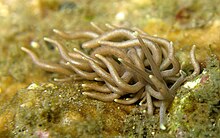| Phyllodesmium | |
|---|---|

| |
| A live individual of Phyllodesmium briareum, head end towards the front | |
| Scientific classification | |
| Domain: | Eukaryota |
| Kingdom: | Animalia |
| Phylum: | Mollusca |
| Class: | Gastropoda |
| Order: | Nudibranchia |
| Clade: | Dexiarchia |
| Suborder: | Cladobranchia |
| Superfamily: | Aeolidioidea |
| Family: | Myrrhinidae |
| Genus: | Phyllodesmium Ehrenberg, 1831 (1828)[1] |
| Type species | |
| Phyllodesmium hyalinum Ehrenberg, 1831 | |
| Diversity | |
| 27 species (in this list) | |
| Synonyms | |
| |
Phyllodesmium is a genus of predatory sea slugs, aeolid nudibranchs, marine gastropod molluscs in the family Myrrhinidae.[2]
These nudibranchs occur in the tropical Indo-Pacific Ocean and warm temperate waters of Japan, Tasmania and South Africa.
The nudibranchs in this genus often show extraordinary mimicry, each species very closely resembling its prey species, which are octocorals, a kind of soft coral.[3]
Some of the species are also unusual in that they are able to utilize zooxanthellae from their prey, in a symbiotic relationship that provides them with extra nutrition from photosynthesis, hence they are commonly called "solar-powered" sea slugs (also see the Sacoglossa).[4]
- ^ Ehrenberg C. G. (1831). Sym. Phys., Moll., sign. h. (plates are from 1828.)
- ^ Bouchet, P. (2012). Phyllodesmium Ehrenberg, 1831. Accessed through: World Register of Marine Species at http://www.marinespecies.org/aphia.php?p=taxdetails&id=204424 on 2012-06-05
- ^ Moore E. & Gosliner T. (18 August 2009). "Three new species of Phyllodesmium Ehrenberg (Gastropoda: Nudibranchia: Aeolidoidea), and a revised phylogenetic analysis". Zootaxa 2201: 30–48.
- ^ Cite error: The named reference
SSF2was invoked but never defined (see the help page).